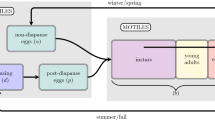Abstract
New formulas for deriving the sensitivities of stable stage structures and reproductive values to changes in vital rates are presented. They enable comparison of the sensities to changes of different elements in the projection matrix; in other words, comparison of partial derivatives of the eigenvectors. These kinds of sensitivities can be used in applied problems such as an analysis of the effect of harvesting on the population structure. However, in this paper, we examine the application of the sensitivities in a more general ecological context. We investigate why the stable stage structure of the mustard aphid,Lipaphis erysimi, changes very little in the temperature interval 10–30°C. The sensitivities of the stable stage structure at 15°C and 25°C were derived. The character of the sensitivites were the same in both temperatures although the stage structure was more sensitive to changes at 15°C than at 25°C. The sensitivity analysis also revealed that the temperature variation results in changes in fecundity and developmental rate that have a counteractive effect on the population structure.
Similar content being viewed by others
Literature
Bellman, R. 1970.Introduction to Matrix Analysis, pp. 288. New York: McGraw-Hill.
Caswell, H. 1978. A general formula for the sensitivity of population growth rate to changes in life history parameters.Theor. Pop. Biol. 14, 215–232.
Caswell, H. 1980. On the equivalence of maximizing reproductive value maximizing fitness.Ecology 61, 19–24.
Caswell, H. 1988. Approaching size and age in matrix population models. InSize-structured Populations. B. Ebenman and L. Persson, pp. 85–105. Berlin: Springer-Verlag.
Caswell, H. 1989.Matrix Population Models. Sunderland, Massachusetts: Sinauer Associates.
Desoer, C. A. 1967. Perturbations of eigen values and eigenvectors of a network, pp. 8–11.Fifth Annual Allerton Conference on Circuit and System Theory. University of Illinois, Urbana.
Getz, W. M. 1979. Optimal harvesting of structural populations.Math. Biosci. 44, 269–292.
Getz, W. M. and R. G. Haight. 1989.Population Harvesting. Demographic Models of Fish, Forest, and Animal Resources. Princeton: Princeton University Press.
Hildebrand F. B. 1965.Methods of Applied Mathematics, pp. 76–77. Englewood Cliffs, New Jersey: Prentice Hall.
Landin, J. and U. Wennergren. 1987. Temperature effects on population growth of mustard aphids.Swed. J. Agri. Res. 17, 13–18.
VanSickle, J. 1977. Analysis of a distributed-parameter population model based on physiological age.J. theor. Biol. 64, 571–586.
Wennergren, U. and J. Landin. 1993. Population growth and structure in a variable environment. I. Aphids and temperature variation.Oecologia 93, 394–405.
Author information
Authors and Affiliations
Rights and permissions
About this article
Cite this article
Wennergren, U., Weinerfelt, P. & Forsling, G. Comparative sensitivity analysis of stable stage structures and reproductive values. Bltn Mathcal Biology 56, 945–957 (1994). https://doi.org/10.1007/BF02458275
Received:
Revised:
Issue Date:
DOI: https://doi.org/10.1007/BF02458275




